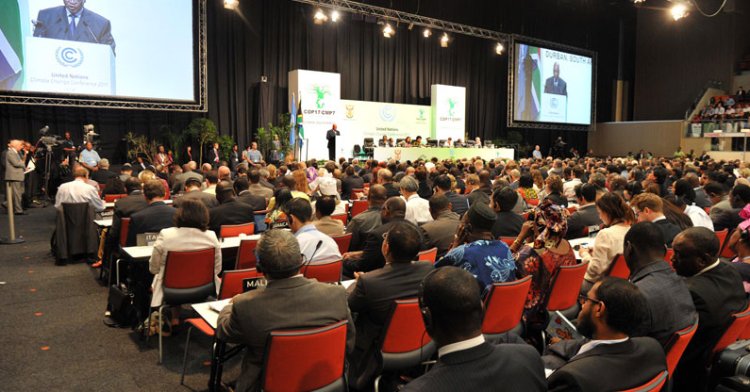The expectations were so low that this time only 12 heads of state assisted to the negotiations, not a single one from the G20, meaning that none of the leaders among the big polluters bothered to show up.
If we look at what was politically possible, the outcome of Durban can be qualified as acceptable; the process is alive and continues to move forward. Concretely, the COP17 succeeded to “agree to launch a process to develop a protocol, another legal instrument or a legal outcome under the Convention applicable to all Parties” (art 2) and it gave itself 4 years to do so “no later than 2015 (...)” although a very late date to enter into force; “and for it to come into effect and be Implemented from 2020.” (art 4). It also managed to create a Green Climate Fund, with the World Bank as a trustee, which is supposed to receive $100bn a year but, with the exception of South Korea, Germany and Denmark, nobody has yet committed to chip money into it. As a result, the Kyoto Protocol will expire leaving it up to the countries to voluntarily reduce their emissions until 2020. The Kyoto protocol, with all its weaknesses of enforcement and limited scope, was the only legally binding treaty for its signatories. However, Canada for instance didn’t hesitate to stab the dying protocol on the back with her withdrawal from the treaty right after Durban in order to avoid paying $14bn for having increased its emissions in one third –according to the protocol it should have reduced them by 6%-. The move from Canada reminds us that no matter how lengthy the negotiations, there is no guarantee that countries won’t walk away from their commitments later down the line.
Indeed, even if Canada had opted for staying inside the Kyoto protocol and refused to pay the $14bn there is little the feeble Compliance Committee could have done other than naming and shaming. After all, one may wonder whether the end of the Kyoto protocol is so sad when the case of Canada illustrates very well how, regardless of the commitments, it is up to the inner motivation of the parties to reduce emissions. The EU is a good example of how what matters when reducing emissions is the political will and not the protocol itself. It is an illusion to think that an international treaty can compel national decision makers to cut emissions faster than their domestic populations are willing.
On the other hand, if we look at the results of Durban from the point of view of what was necessary to avoid catastrophe the results are, once again, an unacceptable failure. While total emissions continue to grow there are no short or mid-term legally binding measures to reduce or stabilise them. If we take a step back to observe the evolution of the climate change negotiations it is fair to claim that the weak link between the problem and the solution is the inadequate governance structure under which the negotiations take place. The current methodology consisting in identifying a common problem –excess of emissions- and trying to agree on national emission limits -the final enforcement of which falling on the country itself – is just not working.
In fact, this methodology can be compared with the methodology that was used in Europe to manage a common problem –war- after World War I; the creation of an organisation –League of Nations- where countries would discuss matters and settle multilateral agreements the enforcement of which was inapplicable. In both cases the methods have proven inadequate; the CO2 emissions, far from stabilising, have increased dramatically same as the League of Nations couldn’t settle the disagreements which led to the World War II.
Same as in the post-WWI period, national governments lack the will to challenge entrenched constituencies to change their ways of life and their vision of the world. And even if one would dare to, this is a clear “prisoner’s dilemma” case in which in the short term there is incentive to collaborate and it rather pays off to free-ride on the good behaviour of others. Another parallelism we can draw between the League of Nations and the UNFCCC is that in both cases the only way for the parties to cooperate, to overcome the prisoner dilemma’s syndrome, is after the cost of non-cooperation has revealed to be higher than the cost of cooperation. It took the Europeans two world wars to politically accept that the risks of integration were worth to be taken. However, so far the price of the cession of sovereignty to create a World Community for the Environment is considered to be higher than the costs of global warming. Considering the scientific evidence and the impressive costs associated to the effects of climate change (according to Lord Stern they amount to 5 to 20% of the world GDP) it is very telling that the national governments regard their sovereignty as something even more precious!
There is still one more thing about the European experience that can be extrapolated to the problem of global climate governance; that is the difficulty of providing common supranational goods without a supranational checks and balances system –judiciary and legislative- and above all without a supranational government –executive- and, as a consequence, a supranational budget. The current European economic crisis highlights how much the lack of an European government and of an European budget are responsible for inadequate action. The parallelism is valid for the UNFCCC negotiations; firstly, without a judiciary capable of penalising those countries breaching the emission limits there is no enforcement capacity. Secondly, without a body representing the citizens of the world –the Conference of Parties represents the governments of the world and as such it can’t represent the common will of the world peoples- the global interest is not pursued. Reality illustrates very well how the sum of national interests is far from being the global interest, rather the opposite. Thirdly, without an empowered global executive, accountable to a global parliamentary assembly, taking the lead and showing the way towards decarbonisation of the world economy it will be in the hands of the G20 –and in the end the G2, China and US- to continue hijacking the fight against global warming. And finally, because if we don’t have the last three institutions it will be very difficult to have a proper budget to invest in the transition to a new industrial model. So far, the absence of a global budget to fight climate change has meant that the financing has gone through bilateral deals in the Clean Development Mechanism and carbon markets which have ended up increasing emissions and fuelling speculation in these very lucrative markets.
The UNFCCC negotiations are providing acceptable deals as regards what is politically possible but continue to fail to provide what is actually needed. Emissions continue to increase and speculation in carbon markets is more profitable than ever. Durban confirmed once again the frightening limitations of the UNFCCC model. In this sense, the precedent of the League of Nations can be a useful example to illustrate what could be the fate of the UNFCCC. The question that humankind faces once again is whether it will take a climate catastrophe of the scale of a world war to realise the real risk of non-integration, to build the political momentum among the peoples of the world and its leaders necessary to create a Global Community for the Environment.


Follow the comments: |
|
